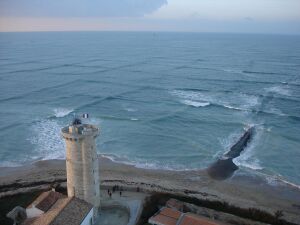Kadomtsev–Petviashvili equation

In mathematics and physics, the Kadomtsev–Petviashvili equation (often abbreviated as KP equation) is a partial differential equation to describe nonlinear wave motion. Named after Boris Borisovich Kadomtsev and Vladimir Iosifovich Petviashvili, the KP equation is usually written as [math]\displaystyle{ \displaystyle \partial_x(\partial_t u+u \partial_x u+\epsilon^2\partial_{xxx}u)+\lambda\partial_{yy}u=0 }[/math] where [math]\displaystyle{ \lambda=\pm 1 }[/math]. The above form shows that the KP equation is a generalization to two spatial dimensions, x and y, of the one-dimensional Korteweg–de Vries (KdV) equation. To be physically meaningful, the wave propagation direction has to be not-too-far from the x direction, i.e. with only slow variations of solutions in the y direction.
Like the KdV equation, the KP equation is completely integrable.[1][2][3][4][5] It can also be solved using the inverse scattering transform much like the nonlinear Schrödinger equation.[6]
In 2002, the regularized version of the KP equation, naturally referred to as the Benjamin–Bona–Mahony–Kadomtsev–Petviashvili equation (or simply the BBM-KP equation), was introduced as an alternative model for small amplitude long waves in shallow water moving mainly in the x direction in 2+1 space.[7]
- [math]\displaystyle{ \displaystyle \partial_x(\partial_t u+u \partial_x u+\epsilon^2\partial_{xxt}u)+\lambda\partial_{yy}u=0 }[/math]
where [math]\displaystyle{ \lambda=\pm 1 }[/math]. The BBM-KP equation provides an alternative to the usual KP equation, in a similar way that the Benjamin–Bona–Mahony equation is related to the classical Korteweg–de Vries equation, as the linearized dispersion relation of the BBM-KP is a good approximation to that of the KP but does not exhibit the unwanted limiting behavior as the Fourier variable dual to x approaches [math]\displaystyle{ \pm \infty }[/math]. The BBM-KP equation can be viewed as a weak transverse perturbation of the Benjamin–Bona–Mahony equation. As a result, the solutions of their corresponding Cauchy problems share an intriguing and complex mathematical relationship. Aguilar et al. proved that the solution of the Cauchy problem for the BBM-KP model equation converges to the solution of the Cauchy problem associated to the BBM model equation in the [math]\displaystyle{ L^2 }[/math] -based Sobolev space [math]\displaystyle{ H^{k}_{x}(\R) }[/math] for all [math]\displaystyle{ k \ge 1 }[/math], provided their corresponding initial data are close in [math]\displaystyle{ H^{k}_{x}(\R) }[/math] as the transverse variable [math]\displaystyle{ y \rightarrow \pm \infty }[/math].[8]
History
The KP equation was first written in 1970 by Soviet physicists Boris B. Kadomtsev (1928–1998) and Vladimir I. Petviashvili (1936–1993); it came as a natural generalization of the KdV equation (derived by Korteweg and De Vries in 1895). Whereas in the KdV equation waves are strictly one-dimensional, in the KP equation this restriction is relaxed. Still, both in the KdV and the KP equation, waves have to travel in the positive x-direction.
Connections to physics
The KP equation can be used to model water waves of long wavelength with weakly non-linear restoring forces and frequency dispersion. If surface tension is weak compared to gravitational forces, [math]\displaystyle{ \lambda=+1 }[/math] is used; if surface tension is strong, then [math]\displaystyle{ \lambda=-1 }[/math]. Because of the asymmetry in the way x- and y-terms enter the equation, the waves described by the KP equation behave differently in the direction of propagation (x-direction) and transverse (y) direction; oscillations in the y-direction tend to be smoother (be of small-deviation).
The KP equation can also be used to model waves in ferromagnetic media,[9] as well as two-dimensional matter–wave pulses in Bose–Einstein condensates.
Limiting behavior
For [math]\displaystyle{ \epsilon\ll 1 }[/math], typical x-dependent oscillations have a wavelength of [math]\displaystyle{ O(1/\epsilon) }[/math] giving a singular limiting regime as [math]\displaystyle{ \epsilon\rightarrow 0 }[/math]. The limit [math]\displaystyle{ \epsilon\rightarrow 0 }[/math] is called the dispersionless limit.[10][11][12]
If we also assume that the solutions are independent of y as [math]\displaystyle{ \epsilon\rightarrow 0 }[/math], then they also satisfy the inviscid Burgers' equation:
- [math]\displaystyle{ \displaystyle \partial_t u+u\partial_x u=0. }[/math]
Suppose the amplitude of oscillations of a solution is asymptotically small — [math]\displaystyle{ O(\epsilon) }[/math] — in the dispersionless limit. Then the amplitude satisfies a mean-field equation of Davey–Stewartson type.
See also
References
- ↑ Wazwaz, A. M. (2007). "Multiple-soliton solutions for the KP equation by Hirota's bilinear method and by the tanh–coth method". Applied Mathematics and Computation 190 (1): 633–640. doi:10.1016/j.amc.2007.01.056.
- ↑ Cheng, Y.; Li, Y. S. (1991). "The constraint of the Kadomtsev-Petviashvili equation and its special solutions". Physics Letters A 157 (1): 22–26. doi:10.1016/0375-9601(91)90403-U. Bibcode: 1991PhLA..157...22C.
- ↑ Ma, W. X. (2015). "Lump solutions to the Kadomtsev–Petviashvili equation". Physics Letters A 379 (36): 1975–1978. doi:10.1016/j.physleta.2015.06.061. Bibcode: 2015PhLA..379.1975M.
- ↑ Kodama, Y. (2004). "Young diagrams and N-soliton solutions of the KP equation". Journal of Physics A: Mathematical and General 37 (46): 11169–11190. doi:10.1088/0305-4470/37/46/006. Bibcode: 2004JPhA...3711169K.
- ↑ Deng, S. F.; Chen, D. Y.; Zhang, D. J. (2003). "The multisoliton solutions of the KP equation with self-consistent sources". Journal of the Physical Society of Japan 72 (9): 2184–2192. doi:10.1143/JPSJ.72.2184. Bibcode: 2003JPSJ...72.2184D.
- ↑ Ablowitz, M. J.; Segur, H. (1981). Solitons and the inverse scattering transform. SIAM.
- ↑ Bona, J. L.; Liu, Y.; Tom, M. M. (2002). "The Cauchy problem and stability of solitary-wave solutions for RLW-KP-type equations". Journal of Differential Equations 185 (2): 437–482. doi:10.1006/jdeq.2002.4171. Bibcode: 2002JDE...185..437B.
- ↑ Aguilar, J. B.; Tom, M.M. (2024). "Convergence of solutions of the BBM and BBM-KP model equations". Differential and Integral Equations 37 (3/4): 187–206. doi:10.57262/die037-0304-187.
- ↑ Leblond, H. (2002). "KP lumps in ferromagnets: a three-dimensional KdV–Burgers model". Journal of Physics A: Mathematical and General 35 (47): 10149–10161. doi:10.1088/0305-4470/35/47/313. Bibcode: 2002JPhA...3510149L.
- ↑ Zakharov, V. E. (1994). "Dispersionless limit of integrable systems in 2+1 dimensions". Singular limits of dispersive waves. Boston: Springer. pp. 165–174. ISBN 0-306-44628-6.
- ↑ Strachan, I. A. (1995). "The Moyal bracket and the dispersionless limit of the KP hierarchy". Journal of Physics A: Mathematical and General 28 (7): 1967. doi:10.1088/0305-4470/28/7/018. Bibcode: 1995JPhA...28.1967S.
- ↑ Takasaki, K.; Takebe, T. (1995). "Integrable hierarchies and dispersionless limit". Reviews in Mathematical Physics 7 (5): 743–808. doi:10.1142/S0129055X9500030X. Bibcode: 1995RvMaP...7..743T.
Further reading
- Kadomtsev, B. B.; Petviashvili, V. I. (1970). "On the stability of solitary waves in weakly dispersive media". Sov. Phys. Dokl. 15: 539–541. Bibcode: 1970SPhD...15..539K.. Translation of "Об устойчивости уединенных волн в слабо диспергирующих средах". Doklady Akademii Nauk SSSR 192: 753–756.
- Kodama, Y. (2017). KP Solitons and the Grassmannians: combinatorics and geometry of two-dimensional wave patterns. Springer. ISBN 978-981-10-4093-1.
- Lou, S. Y.; Hu, X. B. (1997). "Infinitely many Lax pairs and symmetry constraints of the KP equation". Journal of Mathematical Physics 38 (12): 6401–6427. doi:10.1063/1.532219. Bibcode: 1997JMP....38.6401L.
- Minzoni, A. A.; Smyth, N. F. (1996). "Evolution of lump solutions for the KP equation". Wave Motion 24 (3): 291–305. doi:10.1016/S0165-2125(96)00023-6. Bibcode: 1996WaMot..24..291M.
- Nakamura, A. (1989). "A bilinear N-soliton formula for the KP equation". Journal of the Physical Society of Japan 58 (2): 412–422. doi:10.1143/JPSJ.58.412. Bibcode: 1989JPSJ...58..412N.
- Hazewinkel, Michiel, ed. (2001), "KP-equation", Encyclopedia of Mathematics, Springer Science+Business Media B.V. / Kluwer Academic Publishers, ISBN 978-1-55608-010-4, https://www.encyclopediaofmath.org/index.php?title=K/k120110
- Xiao, T.; Zeng, Y. (2004). "Generalized Darboux transformations for the KP equation with self-consistent sources". Journal of Physics A: Mathematical and General 37 (28): 7143. doi:10.1088/0305-4470/37/28/006. Bibcode: 2004JPhA...37.7143X.
External links
- Weisstein, Eric W.. "Kadomtsev–Petviashvili equation". http://mathworld.wolfram.com/Kadomtsev-PetviashviliEquation.html.
- Bernard Deconinck. "The KP page". University of Washington, Department of Applied Mathematics. http://www.amath.washington.edu/~bernard/kp.html.
 |


